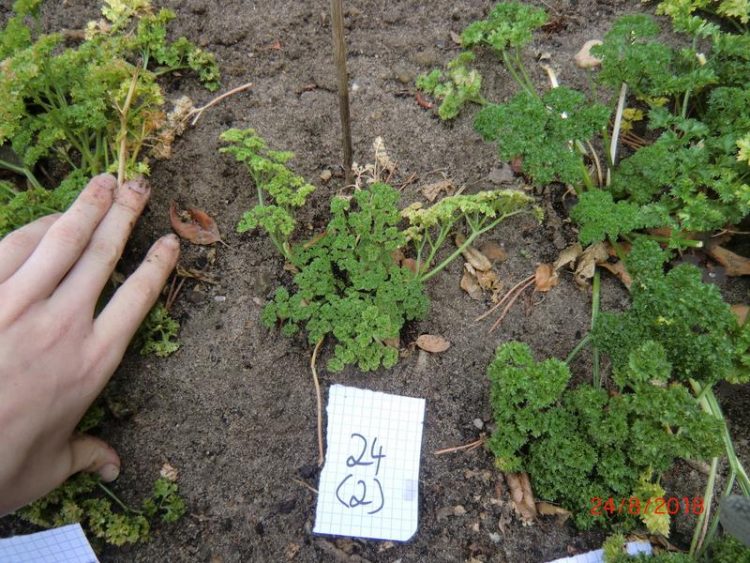New parsley virus discovered by Braunschweig researchers

Infected parsley plant DSMZ
Plant virologists Dr. Björn Krenz and Dr. Stephan Winter from the Leibniz Institute DSMZ-German Collection of Microorganisms and Cell Cultures GmbH in Braunschweig and his colleagues have identified a new parsley virus and published in the peer-review journal Archives of Virology (https://link.springer.com/article/10.1007%2Fs00705-019-04280-3).
The newly described plant virus was isolated from parsley plants in a garden in Weddel, a district of Cremlingen, near the city of Braunschweig in Lower Saxony.
The infected parsley showed dwarfism compared to healthy plants, which could lead to economic losses due to crop loss if the virus spreads.
New nanovirus identified
Using next-generation sequencing at the Leibniz Institute DSMZ, scientists were able to classify the newly identified virus as a nanovirus. The parsley virus genome sequence revealed that it is a new member of the family Nanoviridae.
These are multipartite single-stranded DNA viruses that otherwise only infect legumes such as beans, peas or lentils. The host range of nanoviruses has thus expanded, says plant virus researcher Björn Krenz. The virus is called “parsley severe stunt-associated virus” (PSSaV) and has meanwhile been found in other parts of Germany.
Plant virus research at the DSMZ
Doctor Björn Krenz leads the junior research group VirusInteract at the Leibniz-Institut DSMZ and conducts research with his team on the complex interactions between plants and viruses. The Department of Plant Viruses of the Leibniz Institute DSMZ not only carries out basic research but also the development of diagnostics.
It is accredited according to ISO 17034 as a reference material manufacturer. The Leibniz Institute DSMZ is the world's most diverse collection of bioresources and is celebrating its 50th anniversary this year. In addition to the jubilee event in November 2019, a journalism seminar “Microbes can do more than make sick!” will take place on September 23, 2019, during which the institute's exciting collection and research activities will be presented.
Press contact:
Sven-David Müller, Head of Public Relations, Leibniz Institute DSMZ-German Collection of Microorganisms and Cell Cultures GmbH
Phone: ++49 (0)531/2616-300
Mail: sven.david.mueller@dsmz.de
About the Leibniz Institute DSMZ
The Leibniz Institute DSMZ-German Collection of Microorganisms and Cell Cultures is the world's most diverse collection of biological resources (bacteria, archaea, protists, yeasts, fun-gi, bacteriophages, plant viruses, genomic bacterial DNA as well as human and animal cell lines). Microorganisms and cell cultures are collected, investigated and archived at the DSMZ. As an institution of the Leibniz Association, the DSMZ with its extensive scientific services and biological resources has been a global partner for research, science and industry since 1969.
The DSMZ is the first registered collection in Europe (Regulation (EU) No. 511/2014) and certified according to the quality standard ISO 9001:2015. As a patent depository, it offers the only possibility in Germany to deposit biological material in accordance with the requirements of the Budapest Treaty. In addition to scientific services, research is the second pillar of the DSMZ. The institute, located on the Science Campus Braunschweig-Süd, accommodates more than 69,00 cultures and biomaterials and has 198 employees. www.dsmz.de
The Leibniz Association
The Leibniz Association connects 95 independent research institutions that range in focus from the natural, engineering and environmental sciences via economics, spatial and social sciences to the humanities. Leibniz Institutes address issues of social, economic and ecological relevance. They conduct knowledge-driven and applied basic research, maintain scientific infrastructure and provide research-based services.
The Leibniz Association identifies focus areas for knowledge transfer to policy-makers, academia, business and the public. Leibniz institutions collaborate intensively with universities – in the form of “Leibniz ScienceCampi” (thematic partnerships between university and non-university research institutes), for example – as well as with industry and other partners at home and abroad.
They are subject to an independent evaluation procedure that is unparalleled in its transparency. Due to the importance of the institutions for the country as a whole, they are funded jointly by the Federation and the Länder, employing some 19,100 individuals, including 9,900 researchers. The entire budget of all the institutes is approximately 1.9 billion Euros.
Identification of a novel nanovirus in parsley. Vetten HJ, Knierim D, Rakoski MS, Menzel W, Maiss E, Gronenborn B, Winter S, Krenz B. Arch Virol. 2019 May 11th doi: 10.1007 / s00705-019-04280-3. [Epub ahead of print]
Media Contact
More Information:
http://www.dsmz.deAll latest news from the category: Agricultural and Forestry Science
Newest articles

NASA: Mystery of life’s handedness deepens
The mystery of why life uses molecules with specific orientations has deepened with a NASA-funded discovery that RNA — a key molecule thought to have potentially held the instructions for…

What are the effects of historic lithium mining on water quality?
Study reveals low levels of common contaminants but high levels of other elements in waters associated with an abandoned lithium mine. Lithium ore and mining waste from a historic lithium…

Quantum-inspired design boosts efficiency of heat-to-electricity conversion
Rice engineers take unconventional route to improving thermophotovoltaic systems. Researchers at Rice University have found a new way to improve a key element of thermophotovoltaic (TPV) systems, which convert heat…



